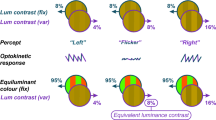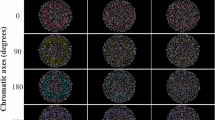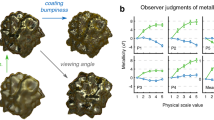Abstract
Aims This paper describes a novel test of colour vision using a standard personal computer, which is simple and reliable to perform.
Methods Twenty healthy individuals with normal colour vision and 10 healthy individuals with a red/green colour defect were tested binocularly at 13 selected points in the CIE (Commission International d'Eclairage, 1931) chromaticity triangle, representing the gamut of a computer monitor, where the x, ycoordinates of the primary colour phosphors were known.
Results The mean results from individuals with normal colour vision were compared to those with defective colour vision. Of the 13 points tested, five demonstrated consistently high sensitivity in detecting colour defects.
Conclusion The test may provide a convenient method for classifying colour vision abnormalities.
Similar content being viewed by others
Introduction
Despite advances in technology and the advertising claims of some television manufacturers about the natural rendition of colour by their products, the range of colours generated by both cathode ray tube (CRT) and plasma screen monitors falls notably short of the full range of colours visible to the human eye, especially in the green part of the spectrum (Figure 1). This is due to the characteristics of the red, green and blue primary phosphors used to generate the colour spectrum. It is not, however, important to be able to generate highly saturated colours for the purpose of human colour vision testing; for example, the CRT monitor more than encompasses the range of colours tested in the Ishihara and Farnsworth-Munsell 100 Hue tests (see also Figure 1).1
Colour plate tests such as the Ishihara test offer a quick and sensitive way of detecting colour vision abnormalities, but they are of limited value in classifying such abnormalities. Colour arrangement tests such as the Farnsworth Munsell 100 Hue test can provide a better degree of distinction between protan/deutan and tritan defects. Both colour testing techniques can be prone to error if ambient lighting is not standardized, and the colour pigments used in the tests can degrade with exposure to light or contact with sweaty fingers. Computer-controlled colour graphics displays, however, allow reproducible presentation of chromatic and luminance parameters, and the process of testing can be made chiefly operator-independent. Most present-day CRT monitors are manufactured using the same set of red, green, and blue phosphors, and therefore tend to be fairly close to each other in their basic colour characteristics.2 There remains, however, a concern over the ageing of phosphors limiting accurate testing, which on the other hand can be solved, albeit partially, by affordable monitor calibrating gadgets.
Several computer-controlled colour vision-testing systems already exist (for example Cambridge colour test (Cambridge research system Ltd., 80 Riverside estate, Sir Thomas Longley road, Rochester, Kent ME2 4BH, England.)), but are inclined to be rather expensive, and they are used principally for research. The aim of this study is to produce and test a system, which is inexpensive and can be used on standard CRT monitors in an ordinary clinical setting.
Method
A program was written in Visual Basic (Microsoft Visual Basic 5.0) to display the full palette (gamut) of colours generated by a CRT monitor (Dell model E771p), by their chromaticity x, y coordinates. The x, y coordinates of the three primary phosphors used in this CRT were identified, and formed the points of a triangle in which the gamut of colours generated by the monitor were displayed. The monitor phosphors x, y values were measured and gamma level calibrated using a colorimetric facility of a monitor calibrating hardware (Spyder with OptiCal software (ColorVision lnc. 303 State Street, Suite 303, Rochester, NY 14614, USA, www.colorcal.com) In total, 13 points within the colour gamut triangle were chosen as test locations, avoiding the central white area (Figure 2).
The chromaticity triangle generated by the program was drawn within a square measuring 200 × 200 pixels. Each pixel within the chromaticity triangle therefore represents a unique x, y coordinate pair. Each point within the triangle is considered surrounded by a small ellipse of chromaticity threshold, within which all points are perceived as the same colour. It would be expected that in anomalous trichromats and dichromats, the chromaticity threshold ellipse would be elongated in the axis of maximum confusion, characteristic of the faulty cone opsin. Protan, deutan and tritan axes of confusion were calculated by drawing a line between the test point and protan, deutan and tritan copunctal points, respectively. The x, y coordinates of the copunctal points used are as follows: protan (0.7455, 0.2565), deutan (1.4, −0.4) and tritan (0.17045,0)3 — see also Figure 2.
The test screen consisted of a two-digit Figure, 90 mm height, drawn with circles of variable size, viewed against a background, also drawn with circles of variable size. Illuminance noise, consisting of 2 × 2 pixel achromatic rectangles with random greyscale values (from 0–255), was added to the spaces between the coloured circles (Figure 3). At each test point, the colour contrast between the figure and the background could be increased or decreased in multiples of 1 pixel, (based on the original colour gamut triangle shown in Figure 2), either side of the test point, along the protan, deutan, or tritan axes of confusion. Two-digit test figures are generated randomly, but not repetitively, and the test strategy is to start at the minimum level of colour contrast and increase it until a figure is read correctly. The screen is viewed from a distance of 2 m. Colour contrast thresholds are measured at each of the 13 test points within the gamut triangle, and along protan, deutan, and tritan axes of confusion at each point. The ambient light is kept to minimum during testing.
Subjects
A total of 20 healthy individuals (age range 10–58 years, 10 female and 10 male) with normal colour vision on the Ishihara test, and 10 otherwise healthy individuals whose Ishihara results indicate a red–green colour defect were tested (age range (6–72 years), all male). The same monitor settings and test strategy are used for all subjects.
Results
In the normal subjects, the mean radius of the long axis of the isochromatic ellipses varied from one pixel up to four pixels. The largest ellipses occurred in the green part of the gamut along the tritan axis. The results are tabulated for each of the 13 test points, and for protan, deutan, and tritan axes of confusion in Table 1. The same results are displayed graphically in Figure 4.
Of the 10 individuals identified on Ishihara testing as having a red–green colour defect, all showed considerable enlargement of isochromatic ellipse radii compared to the mean of normal subjects. In two, the errors were predominantly along protan axes of confusion, whereas in the remaining eight, the errors occurred more along deutan axes of confusion. The typical results for the protanomalous pattern are displayed in Table 2 and Figure 5, and the typical results for the deutanomalous pattern are displayed in Table 3 and Figure 6. It is interesting to note that, while all individuals with defective colour vision show increased chromaticity thresholds at most test locations, the five points towards the blue region of the gamut appear to distinguish most clearly between presumed protanomaly and deutanomaly. In these points, the ratio of the chromaticity threshold of colour defective to the normal subjects (mean threshold) was always more than 2 and predominantly over 3.
Discussion
Isochromatic zones were first measured by MacAdams.4 These were represented by a series of ellipses in the CIE chromaticity diagram. The variation in size of these ellipses demonstrates the differences in individual sensitivity to chromatic stimuli, as well as nonuniformity of the CIE diagram itself. Measurement of chromaticity threshold requires that the test stimulus and the background are equiluminant. Unfortunately, wide individual variations mean that the relative luminance of a range of chromatic stimuli cannot be standardized. It would be possible to balance the luminance between the test figure and the background, for instance using the heterochromatic flicker fusion technique, but this would have to be done for each individual, for each test point and for each confusion axis, and the process would be extremely tedious.
For CRT displays, a background matrix of variable luminance noise has been found to minimize errors due to luminance differences between a test figure and a differently coloured background, during colour vision testing.5, 6 It appears to be an adequate alternative to luminance-balancing techniques and is much less time consuming. One of the remarkable features of the human visual system is a capacity to adjust the gain to maintain sensitivity to small variations in contrast, across a huge range of luminance. When an area of interest is surrounded by bright elements reducing its apparent contrast, the visual system compensates by ‘stretching’ its contrast range, to increase the visibility of dark elements in the presence of a bright surrounding. Conversely, when the region of interest is surrounded by relative darkness, the contrast range of the vision system decreases and the ability to discern dark elements in the scene decreases.7 Adding background luminance noise is likely to stabilize the contrast range of the visual system in the face of variation in the luminance.
In this system, luminance noise is added by interposing small (2 × 2 pixel) achromatic squares with random greyscale values between the coloured circles that form the test figure and background. The 13 test points are distributed over the monitor gamut, but the central white area is avoided because the high luminance and low colour saturation increase the difficulty of distinction between luminance contrast and colour contrast.
Although a variable viewing distance has a significant effect on discriminating colour stimuli in some pseudoisochromatic tests,8 it is assumed that adopting a 2 m viewing distance from the display in our system improves the form discrimination and eliminates edge detection clues from luminance difference.
All individuals with abnormal colour vision on Ishihara testing were clearly shown to have enlarged chromaticity threshold ellipses, in keeping with the expected protanomalous or deutanomalous patterns. Birch et al9, 10 using a colour-matching technique found that the degree and type of colour vision defect could be distinguished from the size and orientation of chromaticity threshold ellipses throughout the colour palette. In this test, the sensitivity of test points varies, with the highest levels of sensitivity for red/green defects in the blue/green part of the palette. On this basis, it seems reasonable to reduce the number of test points from 13 to any of the five points in the blue part of the gamut for testing red/green defects. In our setting, however, the number of subjects is not large enough to investigate the relationship between the severity of colour defect and the size of chromaticity threshold ellipses. Individuals with congenital tritanopia have not yet been tested, so it has not yet been possible to identify the ideal test points for tritan defects.
This study may be criticized for only using the Ishihara test plates for comparison. The Ishihara plate test, however, remains a very efficient screening test for protan and deutan colour deficiency, and on testing no subject with normal colour vision, makes error in a manner indicating red/green deficiency.11 The ability to sub-classify red/green defects into anomalous trichromacy, or dichromacy and protan or deutan patterns is not generally important in the clinical setting. The ability to detect and monitor acquired colour defects is of more importance, for instance in dysthyroid eye disease and suspected retinal or optic nerve toxicity.
This test appears to offer a sensitive, cost-effective, and convenient means of testing colour vision, using equipment that is readily available in the clinical setting. The program strategy can easily be adapted for use with a range of personal computers and monitors, provided that the chromaticity coordinates of the monitor phosphors are known.
References
Lakowski R . A critical evaluation of colour vision tests. Br J Physiol Opt (233); 1966: 186–209.
Sharma G . LCDs Versus CRTs—Color-calibration and gamut considerations. Proc IEEE 2002; 90(4): 605–622.
Fry GA . Dichromatic confusion lines and color vision models. Am J Optometry Physiol Opt 1986; 63(12): 933–940.
MacAdam DL . Visual sensitivities to colour differences in daylight. J Opt Soc Am 1942; 32: 247–274.
Regan BC, Reffin JP, Mollon JD . Luminance noise and the rapid determination of discrimination ellipses in colour deficiency. Vision Res 1994; 34(10): 1279–1299.
Birch J, Barbur JL, Harlow AJ . New method based on random luminance masking for measuring isochromatic zones using high resolution colour displays. Ophthalmic Physiol Opt 1992; 12(2): 133–136.
Poynton CA . Gamma and its disguises: the nonlinear mappings of intensity in perception, CRT, film, and video. SMPTE J 1993; 102(12): 1099–1108.
Long GM, Lyman BJ, Tuck JP . Distance, duration and blur effects on the perception of pseudoisochromatic stimuli. Ophthalmic Physiol Opt 1985; 5(2): 185–194.
Birch-Cox J . Isochromatic lines and the design of colour vision tests. Mod Problems Ophthalmol 1974; 13(0: 8–13.
Birch J . The design of diagnostic tests for defective colour vision. Br J Physiol Opt 1976; 31(4: 32–37.
Birch J . Efficiency of the Ishihara test for identifying red-green colour deficiency. Ophthalmic Physiol Opt 1997; 17(5: 403–408.
Acknowledgements
I thank Mr Richard Smith, Consultant Ophthalmologist/Stoke Mandeville hospital, for his valuable advice and comments after revising this work.
This paper does not serve the financial or proprietary interest of any individual nor institution and has no financial support.
Author information
Authors and Affiliations
Corresponding author
Rights and permissions
About this article
Cite this article
Toufeeq, A. Specifying colours for colour vision testing using computer graphics. Eye 18, 1001–1005 (2004). https://doi.org/10.1038/sj.eye.6701378
Received:
Accepted:
Published:
Issue Date:
DOI: https://doi.org/10.1038/sj.eye.6701378









